Transforming your outdoor space into a lush, eco-friendly haven can elevate both your home’s aesthetic appeal and its environmental footprint. Whether you’re aiming to create a serene retreat, reduce your carbon footprint, or simply enhance your property’s curb appeal, green landscaping ideas offer a multitude of benefits. From selecting the right plants and colors to designing sustainable spaces, this guide explores innovative strategies to craft attractive and eco-conscious landscapes. Discover how green landscaping can bring life to your yard while promoting biodiversity and reducing waste. With expert tips on everything from low-maintenance solutions to cutting-edge sustainable practices, this comprehensive resource will inspire you to reimagine your outdoor space and create a greener, more vibrant environment for years to come.
Key Takeaways
- Adopt Sustainable Practices: Use native plants, organic mulch, and rainwater harvesting to create eco-friendly landscapes.
- Support Biodiversity: Plant native species and incorporate wildlife habitats to boost local ecosystems.
- Embrace Minimalist Design: Design open spaces with natural elements and clean lines for a serene environment.
- Protect the Environment: Reduce pollution, conserve water, and prevent soil erosion through sustainable methods.
- Save Costs Over Time: Enjoy lower maintenance and longer-lasting plants with greenscaping techniques.
- Educate and Inspire: Share knowledge and encourage others to adopt sustainable landscaping practices.
- Build Climate-Resilient Landscapes: Create ecosystems that can withstand extreme weather conditions.
- Use Recycled Materials: Repurpose old materials to lower costs and reduce waste.
- Optimize Energy Use: Implement solar and LED solutions to enhance functionality and efficiency.
- Practice Holistic Landscaping: Combine greenscaping and minimalist principles for a balanced, sustainable outdoor space.
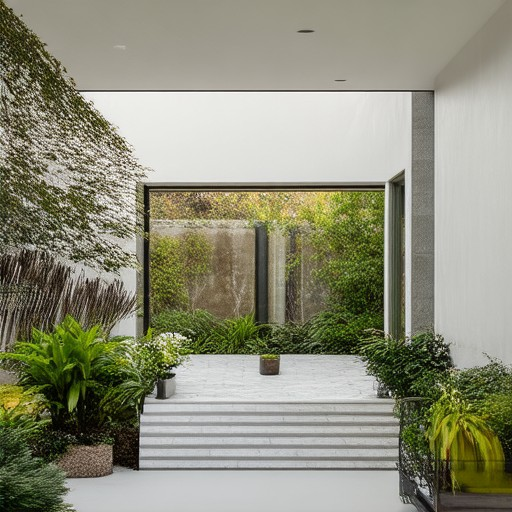
The Rule of 3 in Landscaping
The rule of 3 in landscaping is a simple yet effective design principle that divides spaces into thirds, helping to create balance and visual interest. Here’s how it applies:
- Dividing Spaces:** Use lines, paths, or structures to divide gardens or outdoor areas into thirds. This creates manageable sections and enhances navigation.
- Plant Groupings:** Arrange plants in groups of three to establish symmetry and repetition, making the landscape more visually appealing and easier to maintain.
- Hardscape Elements:** Incorporate elements like patios, walkways, or retaining walls spaced evenly according to the rule of three for a balanced design.
- Lighting and Seating:** Position lights or seating areas every three meters to optimize utility and enhance aesthetic appeal.
This versatile principle ensures that your landscape feels organized, easy to navigate, and aesthetically pleasing, whether you’re working with small or large-scale designs.
The Best Color for Landscaping
Choosing the right color palette for your landscaping project involves understanding how colors influence mood, perception, and overall aesthetic appeal. Here’s a breakdown of key considerations:
- Warm vs. Cool Colors
- Warm Colors : Red, orange, and yellow are stimulating and can make outdoor spaces feel more energetic and vibrant. These colors are ideal for areas where you want to create a sense of warmth and activity, such as patios or garden paths.
- Cool Colors : Blue, green, and purple create a calming effect and are excellent for areas meant for relaxation, like lawns or seating areas. These colors can make spaces feel cooler and more serene.
- Seasonal Considerations
- Incorporate colors that complement the season. For example, deep purples and blues work well in autumn, while bright yellows and oranges are perfect for summer.
- Complementary Colors
- Pairing complementary colors, like blue and yellow or pink and green, can add visual interest and balance to your landscape design.
- Neutral Colors
- Neutral tones like beige, tan, and gray are versatile and can act as a backdrop for more vibrant colors, allowing other elements to stand out.
- Pastel Colors
- Soft pastels like light pinks, blues, and lavenders can create a gentle, inviting atmosphere, making them ideal for smaller spaces or delicate flowerbeds.
- Matching Surroundings
- Consider the colors of your home or fence. Using colors that complement these elements can create a harmonious look.
- Lighting Effects
- Warm lighting can enhance warm-colored landscapes, while cool lighting can highlight cool-toned areas.
- Examples of Effective Palettes
- Monochromatic Gardens : A single color, like all shades of green, can create a cohesive and elegant look.
- Mixed Palettes : Combining warm and cool tones, like a mix of rust, gold, and sage, can add complexity and visual interest.
- Color Wheel Guide
- Use a color wheel to experiment with combinations. Start with a base color and select complementary or analogous colors to create a balanced palette.
By thoughtfully selecting colors that align with your space’s function and personal style, you can create a landscape that feels inviting, cohesive, and visually appealing. For more ideas and inspiration, explore our color palettes guide .
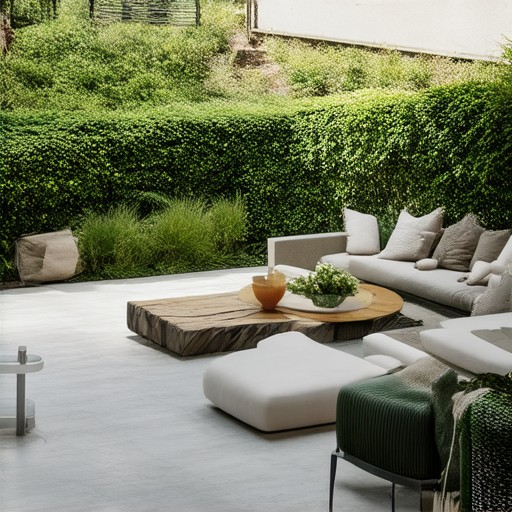
What is the most low maintenance landscaping?
Low-maintenance landscaping focuses on creating beautiful outdoor spaces with minimal effort and resources. Here are some effective strategies to achieve this:
Key Features
- Xeriscaping: Using drought-tolerant plants suited to your local climate, reducing the need for frequent watering.
- Gravel paths: Installing durable, easy-to-maintain pathways that require little upkeep.
- Mulching: Applying thick mulch to retain moisture, suppress weeds, and regulate soil temperature.
Plant Selection
- Native plants: Choosing plants adapted to your region’s conditions, which thrive with less care and attract local wildlife.
- Dwarf varieties: Selecting smaller trees and shrubs that grow quickly and require less pruning.
- Perennials: Planting perennials that return year after year with minimal attention.
Hardscaping Choices
- Decomposed granite: Using eco-friendly materials that reduce runoff and require low maintenance.
- Retaining walls: Building structures to prevent soil erosion without needing constant repairs.
- Patio and deck surfaces: Installing weather-resistant materials that minimize cleaning needs.
Smart Technology
- Smart sprinkler systems: Using water-saving devices controlled by sensors to adapt to weather conditions.
- Automatic timers: Setting up timers for lawn mowing and watering to maintain consistency without oversight.
- Weather sensors: Monitoring conditions to adjust landscaping practices accordingly.
Eco Planeta Verde offers comprehensive guides and resources to help you implement these low-maintenance landscaping ideas. Explore their website for detailed tips, product recommendations, and inspiration to create a sustainable outdoor space that thrives with minimal effort.
For more information, visit Eco Planeta Verde’s Landscaping Page and discover how to enhance your yard with ease and efficiency.
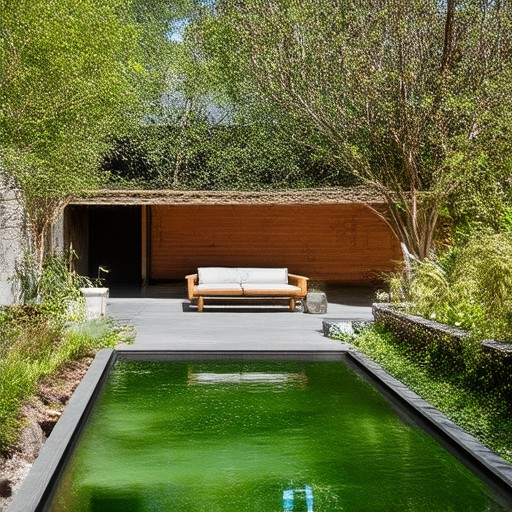
What Is Greenscaping?
Greenscaping refers to a method of landscaping that emphasizes environmentally friendly practices and sustainable techniques. This approach focuses on creating beautiful outdoor spaces while minimizing harm to the environment. Greenscaping incorporates practices that promote healthy plant growth, foster biodiversity, and reduce reliance on synthetic chemicals.
Key Principles of Greenscaping
- Sustainable Plant Selection : Choosing plants native to your region ensures they thrive without excessive water or pesticides. Native plants support local ecosystems and require less maintenance.
- Organic Mulching : Applying organic mulch improves soil health, suppresses weeds, and retains moisture, reducing the need for artificial irrigation.
- Rainwater Harvesting : Collecting and storing rainwater reduces demand on municipal water supplies and lowers utility bills.
- Composting : Incorporating compost into the soil enriches it and reduces the need for chemical fertilizers.
- Biodiversity : Designing landscapes to attract wildlife promotes biodiversity, creating a balanced ecosystem.
- Water Conservation : Implementing drip irrigation systems and xeriscaping (landscaping suited for dry climates) helps conserve water.
- Reduced Chemical Use : Minimizing or eliminating the use of harmful pesticides and herbicides protects beneficial insects and microorganisms.
- Recycled Materials : Reusing materials like old wood or repurposed containers can lower costs and reduce waste.
- Energy Efficiency : Installing solar-powered tools and LED lighting enhances functionality while lowering energy consumption.
- Long-Term Stewardship : Regular maintenance and monitoring ensure the landscape remains healthy and resilient over time.
Benefits of Greenscaping
- Enhances environmental health by reducing pollution and preserving natural resources.
- Reduces long-term costs through lower maintenance needs and increased durability of plants.
- Promotes community engagement by providing educational opportunities and inspiring sustainable practices.
- Contributes to climate resilience by fostering self-sufficient ecosystems.
- Improves air quality by reducing emissions from machinery and chemicals.
Examples of Greenscaping Practices
- Creating wildlife habitats by planting native flowers and shrubs.
- Installing birdhouses and insect hotels to support local wildlife.
- Using permeable paving materials to allow water to filter through the ground.
- Integrating edible landscaping with fruits and vegetables to maximize space usage.
- Utilizing windbreaks and shade trees to regulate temperature and reduce energy use.
- Incorporating rain gardens to manage stormwater effectively.
By adopting greenscaping techniques, homeowners and landscapers can create beautiful, functional outdoor spaces that benefit both people and the planet. Eco Planeta Verde encourages everyone to explore these sustainable practices to contribute to a healthier, more sustainable future. For more tips and resources on implementing greenscaping techniques, visit Eco Planeta Verde .
What is Minimalist Landscaping?
Minimalist landscaping is a design approach that emphasizes simplicity, cleanliness, and a sense of openness in outdoor spaces. It focuses on creating a serene and clutter-free environment, often incorporating natural elements and clean lines to achieve a balanced and harmonious look.
Key Principles of Minimalist Landscaping
- Simplicity: Minimalist landscapes avoid excessive ornamentation, focusing instead on essential elements that enhance functionality and beauty.
- Natural Elements: Incorporating organic materials like plants, stones, and water features creates a connection to nature while maintaining a clean aesthetic.
- Functionality: Minimalist designs often prioritize usability, ensuring that every element serves a purpose without compromising on visual appeal.
- Openness: Minimalist landscapes tend to feel spacious, using soft curves, ample green spaces, and smooth transitions to create a calming effect.
Design Ideas for Minimalist Landscaping
- Open Spaces: Large, uncluttered lawns or garden areas that invite relaxation and social interaction.
- Clean Hardscapes: Simple pathways, patios, or walkways made from natural materials like stone or wood.
- Native Plants: Planting local flora that requires little maintenance and thrives in the region’s climate.
- Water Features: Minimalist ponds, fountains, or waterfalls that add serenity without overwhelming the space.
- Sculptural Elements: Integrating subtle sculptures or art installations that complement the natural landscape.
Benefits of Minimalist Landscaping
- Reduced Maintenance: Simplified designs require less upkeep, making them ideal for busy lifestyles.
- Eco-Friendly: Minimalist landscapes often support sustainability by using native plants and natural materials.
- Aesthetic Appeal: Clean lines and a focus on natural beauty create a timeless and visually pleasing environment.
- Improved User Experience: Open spaces and functional design elements enhance the way people interact with their outdoor areas.
We believe in the power of minimalist landscaping to transform outdoor spaces into peaceful retreats that reflect our commitment to sustainable living. By embracing simplicity and natural beauty, we can create landscapes that inspire and rejuvenate, while staying connected to the environment around us.
Explore more sustainable living tips and gardening ideas on Eco Planeta Verde.
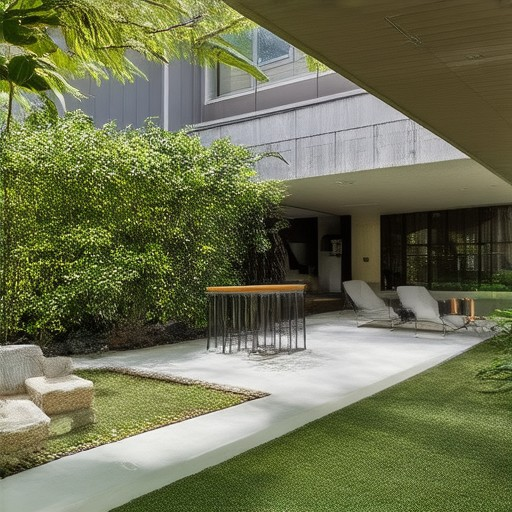
What is the Meaning of Green Landscaping?
Green landscaping refers to the practice of designing and maintaining outdoor spaces in a way that promotes sustainability, reduces environmental impact, and enhances biodiversity. It focuses on creating landscapes that are both aesthetically pleasing and environmentally responsible.
Benefits of Green Landscaping
- Environmental Protection : Green landscaping helps reduce air pollution, conserve water, and prevent soil erosion.
- Biodiversity Support : By planting native species and creating habitats, green landscapes support local wildlife and promote ecological balance.
- Climate Resistance : Sustainable landscapes are better equipped to withstand extreme weather events and climate changes.
- Eco-Friendly Practices : Techniques like composting, rainwater harvesting, and organic mulching minimize chemical use and waste.
Steps to Implement Green Landscaping
- Choose Native Plants : Select plants suited to your region’s climate to reduce water usage and support local ecosystems.
- Use Organic Mulch : Apply mulch to retain soil moisture, suppress weeds, and regulate soil temperature.
- Install Rainwater Systems : Harvest rainwater for irrigation to reduce reliance on freshwater supplies.
- Create Wildlife Habitats : Incorporate birdhouses, bug hotels, and water features to attract diverse species.
- Select Eco-Friendly Materials : Use recycled materials, permeable paving, and natural fencing to minimize environmental harm.
By adopting these practices, you can transform your outdoor space into a haven for nature while enjoying a beautiful, sustainable environment year-round.

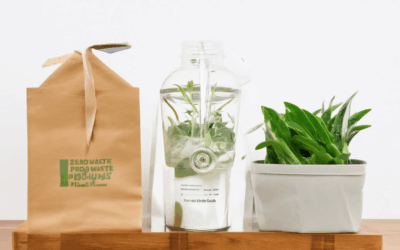


0 Comments